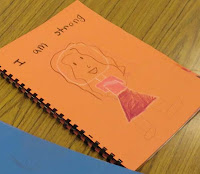 |
| Golden Toad, Illustration by Jamie Hogan for A WARMER WORLD |
Illustrations from A Warmer World will be included in
“Tell Me a Story: A World of Wonders,” an exhibit of children’s book
illustrations by Maine artists at the Atrium Gallery, University of Southern
Maine, Lewiston-Auburn College from June 22 - August 3, 2012. http://usm.maine.edu/atriumgallery
When Boston children's book publisher Charlesbridge Publishing called to ask
Peaks Island, Maine, illustrator Jamie Hogan to illustrate another book for
them, she didn't know how much it would focus her attention on global warming.
Taking up her pastels to depict writer Caroline Arnold's text about the effect
of warming on the world's animals made her reconsider her responsibilities as an
artist and a citizen.
“It changed my radar,” she said.
Hogan's
first task in illustrating
A Warmer World: From Polar Bears to Butterflies, How Climate Change Affects Wildlife (Ages 8-13) was to draw the golden toad,
a creature that used to inhabit the cloud forests of Costa Rica. When the
weather became too warm in the region, the pools where its eggs hatched dried up
and the species was lost.
"I have never drawn dinosaurs, but here I had
to depict a similar animal lost to us forever," said Jamie Hogan. "I found
photos of them in my clipping file. Just in recent decades, the last golden toad
vanished. I was oblivious, as was most of the world. Things are disappearing in
our lifetimes.”
The golden toad is just one of several species
spotlighted in
A Warmer World, a thought-provoking and informative
account of how global climate change has affected wildlife over the past several
decades. Species by species, acclaimed nonfiction children's author Caroline
Arnold describes how warmer weather alters ecosystems, forcing animals to adapt
or risk extinction.
Charlesbridge Publishing suggested the book could be
laid out like a nature journal, with the text appearing on torn pieces of
notebook paper.
"I hunted down various notebooks and tags. Each animal is
labeled with an actual tag collaged over the drawing. Somehow the journal theme
helped me see myself as more involved in the reporting of global warming, as if
I were in the field taking down these notes or drawing beside the author
Caroline Arnold in Costa Rica or on the polar icecap. I wanted kids to pick up a
tactile sense of participation, too—that they, too, could study these effects,
and their attention could lead to change."
Instead of a traditional
marketing approach, Jamie considered how a young reader or classroom teacher
would feel after reading the book. Would they want to do something to prevent
further warming? All the websites she reviewed advocated reusing and recycling,
crucially important tasks. She thought readers might also want to voice their
concern for the featured animals and for global warming. Hogan created a website
to support the book (
www.awarmerworld.com), which allows young citizens to send
electronic postcards that say they are "worried about a warmer world" and
provides links to Congresspersons' email addresses.
"Some see global
warming as no more than a fluctuation in our environment and suggest that kids
need not care about the effects, but it’s their world. Improving our stewardship
of the planet can only help.”
Jamie Hogan and her fellow Peaks Islanders
live almost on a small planet of their own. Trash must be carted off island, and
many things are reused, repaired, and even incorporated into artwork by the
island's many creators. People walk, bike, and share rides every day to keep car
use low on the island.
"Surrounded by a bay full of creatures we see (the
brief bobbing head of a seal) and those that we do not makes us aware we are
part of the environment, not distanced from it. When you take the ferry to town,
you recognize we are simply all on the same boat."
A Warmer World:
From Polar Bears to Butterflies, How Climate Change Affects Wildlife may
help young readers become young citizens who see humans and animals as "all on
the same boat."
 |
| Nesty Nook for Reading at the Atrium Gallery |
Jamie Hogan's Website:
http://www.hoganbraun.com/J_home.html
Jamie Hogan's Blog:
http://jamiepeeps.blogspot.com/
With thanks to Kirsten Cappy for this terrific piece about Jamie and news of the exhibit in Maine. I love the giant nest where children can read books at the Tell Me a Story: World of Wonders exhibit.







































